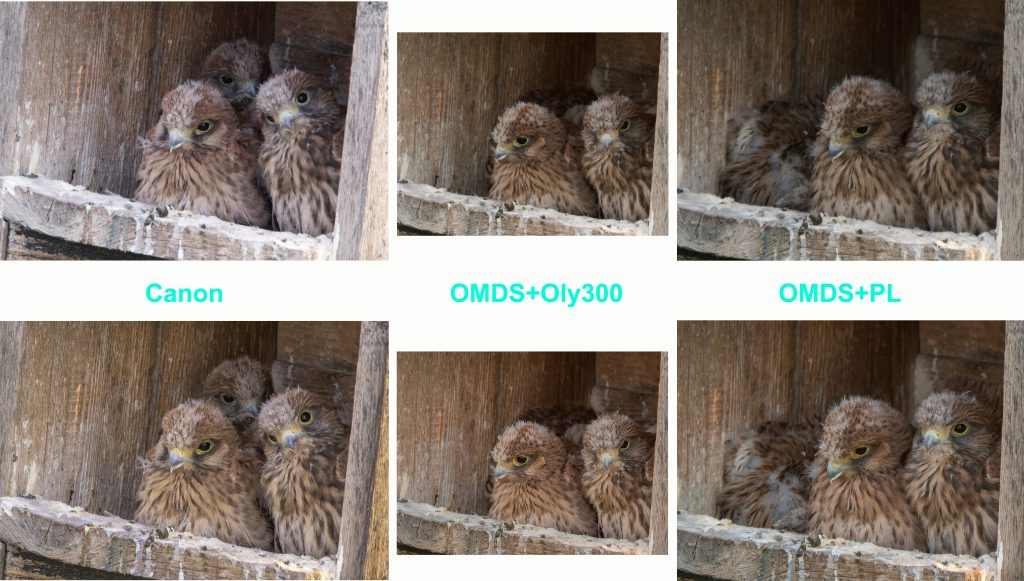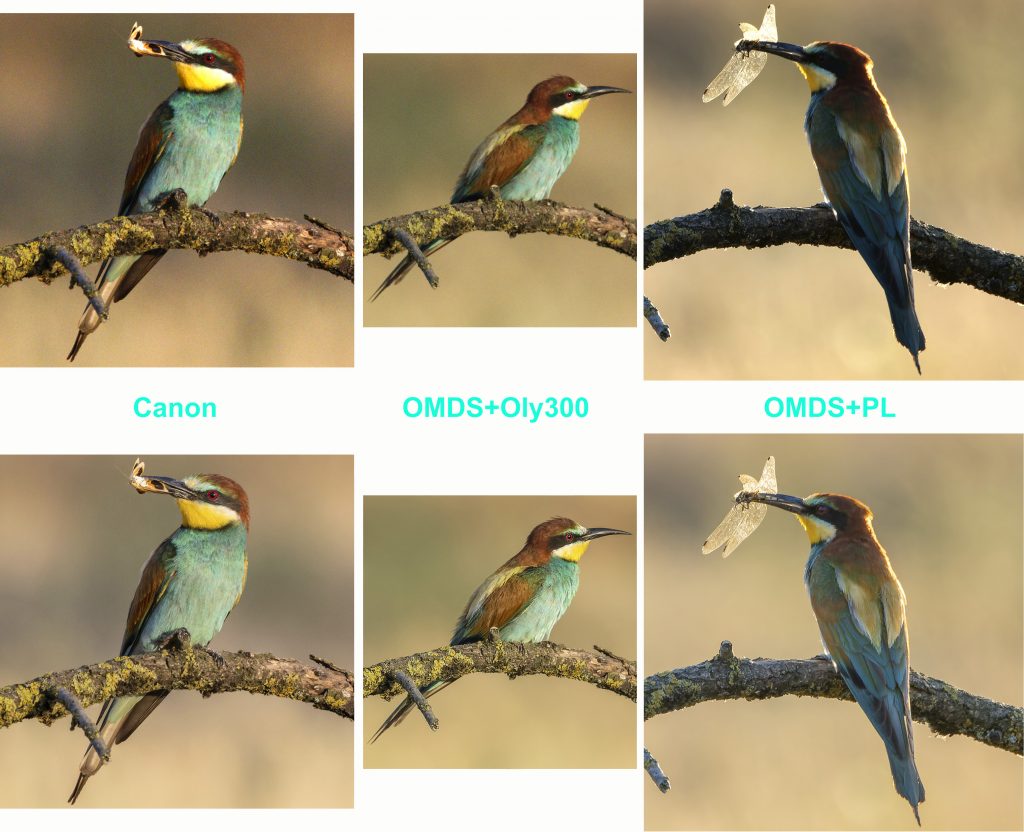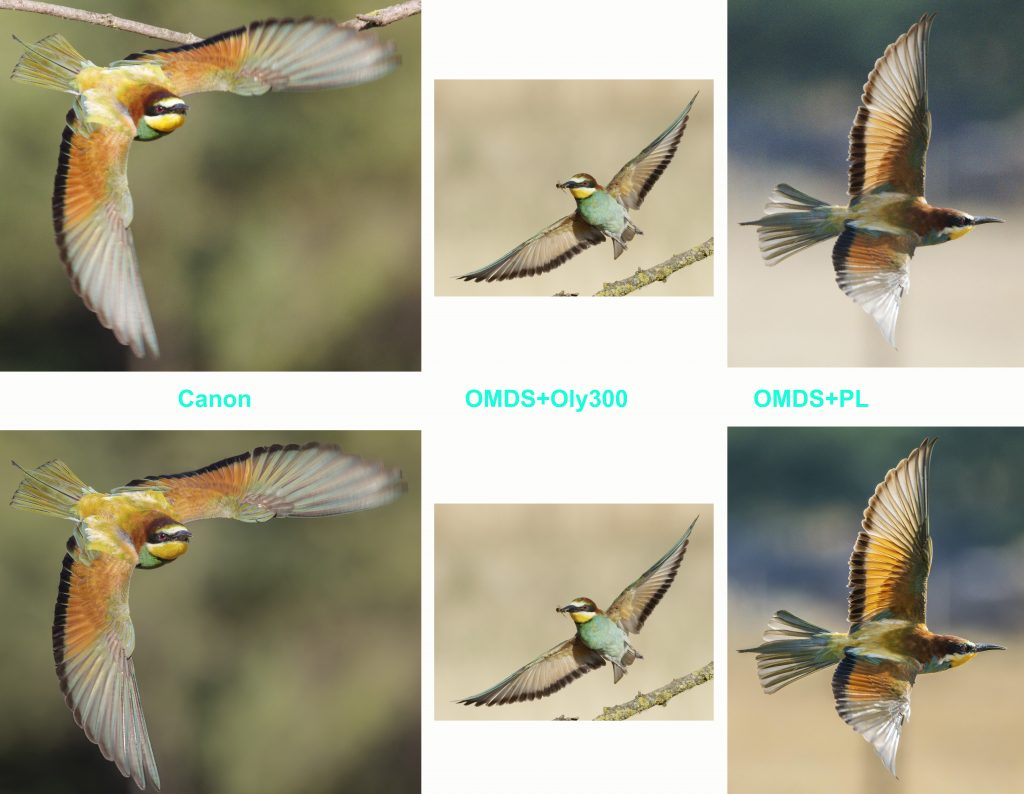Five body/lens combinations for mobile bird shooters: Part IV
Sample shots:
A frequent argument made on photographer forums, though not necessarily a correct one, is that “only real-life shots allow a true comparison”. For those subscribing to that school of thought, here are a few comparative shots. The first ones were taken during my general testing and have been edited to taste. They do demonstrate that each of these combos is able to produce a pleasing image. While the one taken with the PL isn’t quite at the same sharpness level as the others, which may also be true for the one taken with the Oly 300, albeit to a smaller degree, they are not far behind, either.

More systematic comparisons were conducted with the combos I took on a week-long dedicated birding trip to Hungary. I did not take the Nikon along for that trip, and the Big White was not yet in my possession.
The upper row in each series shows non-processed cropped images, converted from RAW to JPEG in DxO Photolab with only minor exposure adjustments for easier comparison, whereas the lower one always shows the same crops processed as I normally would process such images.



In my view, the Oly 300 wins the falcon chicks competition, while the Canon wins both of the bee-eater ones, but this well reflects how the MANY shots I took came out overall: it is hard to make out a clear winner between Canon and OM-1 + Oly 300, whereas the OM-1 + PL combo performs at a slightly lower level. Nevertheless, all of these shots are worth looking at, and none of them pales in comparison to the others, which is testimony to the PL’s still-good performance. The BIF shots taken with the Canon hint at the greater DoF challenge with FF gear vs. MFT, which might have called for a smaller aperture here.
A word about cropping is on order: I argued earlier that the Nikon and Canon will give you almost the same image size when cropped to 800mm as the OM-1 does with the PL lens, so all three combos produce similar results, as several of my test shots confirm. There is one aspect to this that I did not mention, however, and it is one that matters a great deal for bird shooting: “cropability”. With the OM-1, you have to get the framing right while shooting, unless you want to crop to an even smaller image size than its native 20.4MP. With the Nikon and Canon, you get to make that choice later if you wish: their 45 or so megapixels give you ample opportunity to decide in post how exactly to crop in order to produce that same image size. This makes little difference when shooting perched birds, but it is an advantage for the FF bodies here that should not be underestimated. Especially when shooting BIF and dealing with species whose flight patterns are erratic and thus hard to predict, the ability to crop later makes life a lot easier.
While the R5 generally produces a bit more detail, none of these combos disappointed. When a bird nearly fills the frame, because it is either large or in close proximity, a high-res full-frame body has an advantage as you get “more pixels on the bird”. When it flies erratically, that same body again has an advantage because of better “cropability”. In all other cases, however, the MFT combo delivers similar overall image quality while ProCapture gives it an edge.
Before wrapping up, let’s talk about one more aspect of high ISOs, namely where the limits are and what to do about noise:
If you shoot against blue sky in good light, this is not an issue, but the types of birds I prefer to shoot are mostly down in the shrubs where the light is average on a bright day and dim on others. High ISOs are often the norm for me. In my view, ISO6400 is perfectly ok on any of these bodies, and I do go up to ISO12800 on any of them, even if that means high noise. I would not go any higher with the OM-1, though the Nikon and Canon are still “decent-ish” at ISO25600.
In this day and age of editing software performing miracles, post processing will help a great deal. Some photo forum posters already said that the OM-1, where noise is a bigger issue because of its much smaller sensor, seems to collaborate very well with DxO Photolab (or maybe it is the other way around?). Photolab 5.3 now fully supports ORF RAW files and lens corrections with the OM-1. When factoring in other editing wizardry, it is absolutely mindboggling how even a lousy mis-focused shot with terrible noise can be rescued, even made to look rather pleasing. Take a look at the below before-and-after example, shot at ISO 12800, the ‘after’ being courtesy of DxO’s DeepPRIME, Topaz’ Sharpen AI, and Lightroom Classic. Still not a great shot, even after substantial editing, but a usable one at least. Would you have thought so when looking at the original shot?

My personal conclusions [please note I said ‘personal’]:
As a long-time Nikon shooter, I would have loved for the Nikon combo to come out ahead. If Nikon had a non-gripped body performing close to the AF systems of the other two and shooting at decent frame rates, that might well have been the outcome. The Z9, however, is substantially larger and heavier (and pricier) than any of the bodies tested here; in fact, it weighs more than two OM-1s taken together, which kills it for me. As is, the Z7ii is Nikon’s main competitor in this field, and –after the company’s recent price hikes– not a cheap one at that. While it delivers fantastic image quality and performs well in most categories, including many AF situations, it it a full notch behind the R5 and OM-1 when it comes to finding and tracking birds, both when the light is poor and when the animal is moving. The 500 PF is a stellar performer and makes up for some of the body’s AF shortcomings, but unfortunately not all of them. At the same time, none of the other lenses are poor performers, either. All else being (almost) equal, using a zoom also offers an intrinsic advantage over using a prime lens, which favors the Canon, Oly 150-400 and PL lenses. Having said all this, I am nevertheless convinced that Nikon will be very competitive again in this space once they updated the Z7 to version iii and gave it a higher frame rate and AF performance closer to the Z9.
For now, this leaves Canon and the three MFT combos competing for the top spot – assuming there is one. The Canon R5 with the RF 100-500 lens is pretty expensive, and a little larger and heavier than I like, but this is a great rig nonetheless. Nikon’s 500 PF clearly beats the Canon lens in sharpness, but the RF 100-500 performs well enough and complements the R5’s stellar AF performance with good AF speed and accuracy. The Canon’s layout and overall usability are excellent, making it no surprise that this combo is many a bird and wildlife photographer’s favorite. The overall image quality is excellent. If Canon took a few notes from Olympus’ respectively OMDS’ song sheet (hint: “ProCap”) and managed to shrink the lens a bit, the R5 / RF 100-500 combo might represent a mobile bird photographer’s nirvana. Even better might be the Olympus 150-400 on the R5 in that case, but let’s stop dreaming here…
As is, the OM-1 presents a viable alternative to the Canon gear, with both advantages and disadvantages that make it hard for me to pick a winner.
Let’s be clear: there is an IQ hit with MFT, and the OM-1’s dynamic range is somewhat inferior, meaning a higher risk of clipping due to over-/under-exposure. Nothing else should be expected from an MFT sensor compared to full-frame ones, so this shouldn’t be any surprise. Neither effect is as big as I thought it would be, though, so take this with a grain of salt.
Small IQ differences notwithstanding, and as I noted in my detailed exploration, it is not merely in size and weight where the MFT combo is appealing. To me, Pro Capture is a big thing. It opens the doors to aspects of bird shooting that are difficult to manage otherwise. Good bird lift-off and landing shots are few and far between. Olympus/OMDS changed that, and I love it. The OM-1 also focuses very well, almost at the level of the R5, which is excellent. With quality MFT lenses, the OM-1 is a solid choice for birding. It becomes a stellar one with the expensive-but-great Big White lens.
Is the OM-1 with the Big White the better option when comparing it with the Canon rig, and is it worth the higher price? It depends. There are shooting situations where one is better than the other, and vice versa. The OMDS/Olympus combo delivers slightly better sharpness, while other IQ aspects speak for Canon. The TC built into the Big White is a substantial advantage, as engaging it takes nothing more than flipping a switch. Do these advantages warrant the price delta of $2,900? Everyone needs to decide for him-/herself.
How easy and comfortable is it to shoot and get great bird/BIF shots with any of these combos?
For starters, all of them feel well balanced. Not one of them, not even the Big White, suffers from the front heaviness for which older lenses are infamous. As far as firing away without having to take the camera down in order to fiddle with settings goes, the Canon comes in first, the OM-1 second, and the Nikon comes in a distant third. It would surely benefit from having more customizable buttons on the back. The OM-1’s four custom modes came in handy vs the Canon’s and Nikon’s three, as it allowed me to set up a dedicated ProCap mode.
As far as getting the shot you want goes, the Canon combo is the closest thing to “idiot proof”. It takes relatively little skill to get decent, even outstanding bird shots with this combo. This is a bit harder with any of the OM-1 combos, mainly owing to slightly more complex controls and less room for cropping. With practice, all of these allow you to concentrate on timing and framing, though, rather than getting overly focused on the technical aspects of shooting. The Nikon, in contrast, requires excellent technical skills and then still puts you at a disadvantage when trying to get that crucial shot you’ve always wanted to get. If you nail it, however, its overall IQ will be just about perfect, and the 500 PF lens is as sharp as a knife.
I mentioned cost only in the beginning. If you are looking for best value for money, there can be no doubt that the OM-1 with the PL lens, with a combined price of just over half of the Canon or Nikon gear, is the best choice among these. It is also the smallest and lightest set here, and one that still produces impressive results.
MFT or Canon? For now, I’ll keep both. The Canon probably won’t come along when I travel internationally, which I do quite often. [This year alone, I have been or will be going to Costa Rica, the U.S., the Canary Islands, Switzerland, Hungary, Iceland, mainland Spain, Singapore, Australia, and of course, Germany, where I live. Then, there are New Zealand and Indonesia during the first six weeks of next year.] There will still be occasions where I expect to use and prefer the Canon combo. If I had to choose, however, I would drop the Canon gear, and I already noticed in Hungary, where I did not even have the Big White, that I tended to be pulled towards the OM-1 more than I used the R5.
How do the three MFT lenses compare side-to-side? In a nutshell, you get what you pay for. The Big White is a stellar lens at a substantial price. Its performance is remarkable, given how well it competes with Nikon’s 500 PF lens sharpness-wise while offering much longer range and the flexibility of a zoom. The Olympus 300mm has the disadvantage of producing the smallest image area in this test, but its 600mm FF equivalent is ample for most shooting situations anyway. As an f/4 lens, it affords higher shutter speeds than the others, while its f/8-equivalent depth of field is an advantage over the Nikon and Canon for bird shooting. On the other hand, paired with a 1.4x TC, my copy of the Oly, now at an FF equivalent of 840mm, performed only slightly above the level of the PL lens with its 800mm FF equivalent, which is to say that the Panasonic Leica 100-400 f/4-6.3 held its ground well enough. The latter lens is not quite as sharp as the others I tested, but it performed more than decently and, given its size, reach, and DoF, is definitely worth having.
In my opinion, all of these lenses have their place. Since Olympus’ fantastic 150-400 f/4.5 PRO lens with its built-in 1.4x TC essentially offers a super-set of the 300mm f/4 PRO, I will likely sell the latter. The Panasonic Leica 100-400 stays, as it is very handy when I want or need to pack light.
This wraps up my comparison. Hope you found it valuable! If you would like to share your personal thoughts and comments with me, please email me at lothar (at) katz-us.com.
Lothar Katz
July 2022